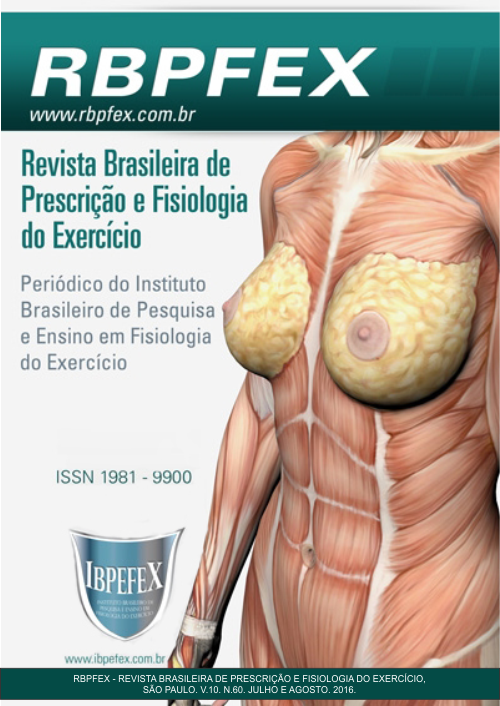Pressure physiological response characteristics blood in exercise weathered
Abstract
The physiological response of blood pressure (BP) during the (PE) exercise, specifically endurance exercise (RE) or bodybuilding, as it is popularly known, raises questions of the practitioners of this modality and researchers are intensifying studies in the area because these physiological responses and present variations are influenced by several factors that are directly in the form of implementation of the RE. Therefore, the study aimed to verify the physiological response of the variation in blood pressure that results in body position, body segment (upper and lower) are used, assets, liabilities and blocked breaths, and overloads 50% and 80% intensity of the maximum load imposed on the execution of the movement. The tests were applied to 45 exercises Leg Press, triceps front, hack squats, triceps Development (French-bar) President extensor and triceps Tire (pulley), respectively. For the analysis of one-way ANOVA and Tukey statistical post-hoc was used with a significance level of 0.05 p0. It was found that resistance training of the lower extremities Leg Press 45 was the number that showed elevated BP in both overload and worked in the three breaths. Upper extremities and all resistance exercises showed a rise in blood pressure, but there was a higher elevation in quantitative comparison between exercises. However, when compared statistically, only a few exercises showed significant differences in relation to body position and breathing used. However, compared with the end of AP between exercises of the upper and lower limbs, the beginningand end of each year of AP, significant differences in all breaths were observed. Therefore, more repetitions with lower intensity exercise results in a greater increase in blood pressure in the lower extremities, which occur in the upper limbs otherwise.These factors reconciled with the breath (Valsalva maneuver) blocked and body position in the execution of the exercise resulted in higher elevations of blood pressure in the legs, with a passive breathing compensation that resulted in lower BP values observed during the study
References
-Borg,G. Escalas de Borg para a dor e o esforço percebido. Manole. 2000.
-Brzycki, M.Strength testing: predicting a one-rep max from repetitions to fatigue. JOPERD. 1993.Vol. 64. p.88-90. Disponível em: <http://docsfiles.com/pdf_brzycki_m_1993.html>.Acessado em 10/05/2013 às 23:00h.
-Beachle, T.R.; Groves, B.R. Treinamento de Força, passos para o sucesso. 2ª edição. Porto Alegre. Artmed. 2000.
-Forjaz, C.L. M.; Rezk, C.C.; Melo, C.M.; Santos, D.A.; Teixeira, L.;Nery, S.S.; Tinucci, T. Exercício resistido para o paciente hipertenso: indicação ou contra-indicação. Revista Brasileira de Hipertensão. Vol. 10. 2003.
-Hawerroth, D.; Kulkamp, W.; Wentz, M.D. Exercícios resistidos e qualidade de vida: impacto na capacidade funcional e benefícios terapêuticos. Revista digital. Núm. 143. Buenos Aires. 2010.
-Krug, A. L. O.; Souza, A.F. Respostas agudas imediatas de pressão arterial em diferentes equipamentos de flexão de joelhos. Revista digital. Núm. 133. Buenos Aires. 2009.
-Lima, V. P.; Musculação: a prática dos métodos de treinamento. Rio de Janeiro. Sprint. 2009.
-Lisboa, G.; Abreu, D.G.; Cordeiro, L. S.; Knifis, F. Verificação das alterações provocadas pelo exercício contra resistência no indivíduo hipertenso. Revista de Educação Física. Núm. 137. 2007.
-Lizardo, J. H. F; Simão, H. G.: Efeitos de diferentes sessões de exercícios resistidos sobre a hipotensão pós-exercício. Revista Brasileira de Fisioterapia. Vol. 9. Núm. 3. 2003.
-Lopes, L.T. P.; Gonçalves, A.; Resende, E.S.; Resposta do duplo produto e pressão arterial diastólica em exercício de esteira, bicicleta estacionária e circuito na Musculação. Revista Brasileira de Cineantropometria e Desempenho Humano. Vol. 8. Núm. 2. 2006.
-Meirelles, F.; Teixeira, A. L.; Dias, M.R. Respostas cardiovasculares entre exercícios de membros superiores e inferiores com diferentes padrões de respiração. Revista Brasileira de Ciência e Movimento. Vol. 23. 2013.
-Novaes, J.S.: Ciência do treinamento dos exercícios resistidos. São Paulo. Phorte. 2008.
-Polito, M. D.; Farinatti, P. T. V.: Comportamento da pressão arterial após exercícios contra resistência: uma revisão sistemática sobre variáveis determinantes e possíveis mecanismos. Revista Brasileira de Medicina do Esporte. Vol. 12. Núm. 6. 2006.
-Polito, M.D.; Farinatti, P. T. V.: Respostas de frequência cardíaca, pressão arterial e duplo-produto ao exercício contra-resistência: uma revisão da literatura. Revista Portuguesa de Ciências do Desporto. Vol. 3. Núm. 1. 2003.
-Schmitz, E.; Schmitt, R.S.; Variações da Pressão Sanguinea e Frequência Cardíaca no trabalho de força nos exercícios de Leg Press 45º e Agachamento Hack. Centro de Ciências da Saúde da Universidade Regional de Blumenau. Blumenau, 2010. Disponível em: . Acessado em 27/10/2013 às 10:45h.
Authors who publish in this journal agree to the following terms:
- Authors retain the copyright and grant the journal the right of first publication, with work simultaneously licensed under the Creative Commons Attribution License BY-NC which allows the sharing of the work with acknowledgment of the authorship of the work and initial publication in this journal.
- Authors are authorized to enter into additional contracts separately for non-exclusive distribution of the version of the work published in this journal (eg, publishing in institutional repository or book chapter), with acknowledgment of authorship and initial publication in this journal.
- Authors are allowed and encouraged to post and distribute their work online (eg, in institutional repositories or on their personal page) at any point before or during the editorial process, as this can bring about productive change as well as increase impact and impact. citation of published work (See The Effect of Free Access).






